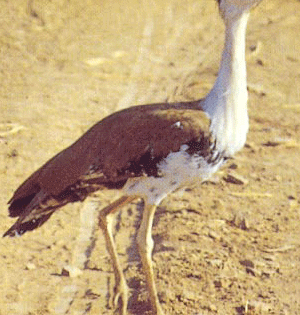Karnataka Siruguppa can become a breeding centre for endangered Great Indian Bustards
By Anubha Jain | Published: July 24, 2023 04:11 PM2023-07-24T16:11:42+5:302023-07-24T16:13:11+5:30
An ostrich-like bird with a long neck, thin long bare legs with one-meter height, and 10-15 kg. in weight, ...

Karnataka Siruguppa can become a breeding centre for endangered Great Indian Bustards
An ostrich-like bird with a long neck, thin long bare legs with one-meter height, and 10-15 kg. in weight, the Great Indian Bustard (GIB). GIB, a critically endangered species under the Wildlife (Protection) Act, of 1972 is indeed closest to extinction or disappearance. But now if appropriate and suitable efforts and facilities will be applied then in the coming years Karnataka Ballari district’s Siruguppa can become a breeding centre for endangered Great Indian Bustard GIBs. The Karnataka Mining Environment Restoration Corporation has sanctioned Rs. 24 crore and approved a special project for GIBs conservation at Siruguppa. The fund will be utilized for improving GIB habitat in 24 villages of South India where the bird is currently found.
As per the 2021 report of the International Union for Conservation of Nature (IUCN), the population of the Indian bustard is on the decline for the last several years. Bustard's population shrunk from 1260 in 1969 to 600 in 2001 and 300 in 2008. And presently, there are merely 135 GIBs nationwide and most of them are found in the desert state of Rajasthan. The GIBs were first spotted in the year 1982 in Andhra Pradesh Kurnool’s district Rollapadu. But over the years with a population decline, the Rollapadu Bird Sanctuary especially for the Indian Bustard has not reported any spotting of GIBs there. A small number of GIBs are also seen at Karera Sanctuary in MP, Naliya Sanctuary in Gujarat’s Kutch, Maharashtra Great Indian Bustard Sanctuary, and Nannaj Grasslands, Solapur. It is to be noted that Karnataka used to be an abode for a large number of GIBs in the wild. Now Siruguppa in South India is emerging as one of the most promising sites for this grassland bird and it has the second-highest population of GIBs in the wild.
Recently, a five-member team of forest officials and wildlife connoisseurs visited Rajasthan to know the requisites for improving the Siruguppa habitat for GIBs. The wildlife warden of Ballari informed that the team members understood the kind of grasses to be grown in these protected areas for GIBs to get sufficient feed and safe surroundings for breeding. According to the warden, as the department gets proper land for GIB the area will be protected for stopping or minimizing human and other interference.1000 hectares of land is planned to be purchased from farmers by the forest department under the compensatory afforestation scheme, where companies that have taken forest land compensate with the same amount of land to the forest department for afforestation. Ballari Deputy Conservator of Forest said that without burdening the government through the compensatory afforestation scheme the department will get the land for GIB conservation. The department is also running an awareness program among people to conserve the GIBs.In the near future, with approval and agreement GIBs from Rajasthan's national conservation breeding centre can be released to Ballari’s Siruguppa.